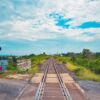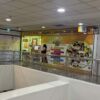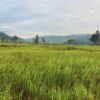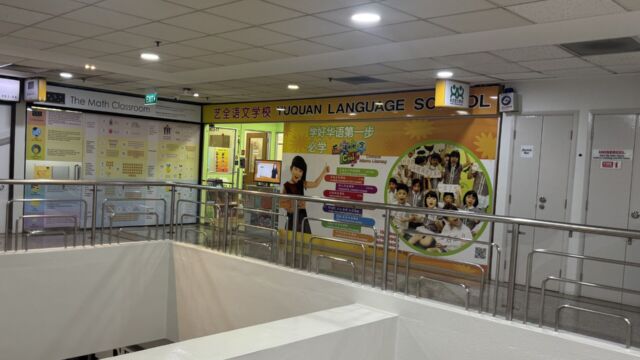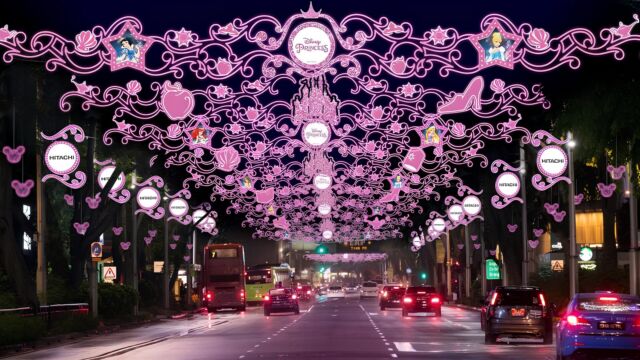Deep in the Singaporean Rainforest
Into the wild. Photo: Amanda Ruiqing Flynn
Telok Blangah Hill Park | 2,562 words
I eye my worn green Mizunos wearily as they sit, laces untied, on my front step.
“You’ve betrayed us,” Left Foot guilt-trips me.
“Yeah, where are all the adventures we’d been promised in Singapore?” chimes in Right Foot.
They are right. These trainers had lived an exciting, adventurous former life. They had been to the top of Mount Fuji, deep into the verdant mountain trails of Taiwan, explored the rugged hills of northern Vietnam. Over the last two years, they had sat neglected on my front step, collecting dust, replaced instead by more trendy city flats suitable for light walking on tarmac streets and in shopping malls. Despite good intentions, the upheaval of moving country, a pandemic, a new marriage, a new baby, meant that all ideas of adventure had flown out of my mind until now.
I can no longer ignore the part of my heart that has been begging for green, for trees, for an area where I can see the sky and plants and animals. I can’t breathe in this city anymore. No more roads, no more construction, no more man-made-ness for me.
I pick up my Mizunos, apologizing profusely to them. Then I slip them on. I have passed by a big inviting sign—Telok Blangah Hill Park— a few times. This Friday morning is finally the time for exploration. To me, the word “park” in Singapore usually conjures up images of flat manicured lawns with small patches of grass, intermittently littered with conveniently positioned dustbins. This park seems different. Wilder, scarier, braver.
*
My eyes gaze up the moderate incline to my left, just off Henderson Road. The path winding upwards from the entrance of the park spooks me a little simply because it is ten in the morning and there is not a single soul in sight, which feels strange for Singapore. I see nothing but dense green foliage flanking that path, who knows what’s hiding within the bushes? I could choose to go for a jog along the busy main road instead.
I look down uncertainly at my trainer-clad feet, and remember that they have never let me down through even the most difficult of conditions. They stayed with me when I twisted my ankle three kilometres into Taiwan’s Taroko half marathon. I ran the remaining eighteen kilometers on their padded soles and sheer adrenaline alone. Of course, I went straight to A&E afterwards and paid the price. So, these shoes came to symbolize bravery, resilience, the willingness to take risks.
Four years later, I am in a different country, a different life, and I must hold on to all these qualities to keep me grounded here in Singapore. Scared of this park? I chide myself for being such a chicken. I will no longer allow city life to make me weak and pathetic. Step by step, I walk forward. I leave behind the hectic pedestrians and traffic pollution at the base of the hill. The steady gait of my feet reassures, comforts.
*
Within minutes, my whole body loosens, like the strings of a violin cut slack. My mind and body had been craving a sense of wilderness for so long, but I hadn’t been able to find it on this island until now.
Telok Blangah Hill Park seems more like a cultivated jungle than a park. Around me is a symbiotic ecosystem of plants and animals living together. Trees lean and twine themselves around each other for support. Roots burrow deep in the soil. Canopies reach for the sun.
There is a breeze. I look upwards. I feel the wind caressing my bare arms and hear the trees, over a hundred years old, rustling as a synchronized symphony of waves. I breathe in the smell of peat, of chlorophyll, of oxygen being produced, of life, of health.
Around me, colors dance, emerald greens mixing with lime greens and turquoise; pillars of burnt umber, sand and dark brown provide a sturdy backdrop. Through millennia, we humans have tried to capture such colors in tube form so artists can immortalize nature on canvas, but the real deal is always better.
To be in the here and now takes mammoth effort. I reflexively reach for the phone in my pocket and then force my arm to draw back, resisting the urge to record the moment. When my monkey mind reaches into my brain for my to-do list, I stuff it away back to the depths where it belongs.
I pause. I breathe in, out. My heart slows, My pores open. Tension dissipates. I stretch. I observe the woods beyond the dense foliage. I notice ants, worms, mynah birds. An oriole, bright yellow, swoops by. A spider the size of my palm has made its web and sits king-like between two trees.
Cockle-doo-dee-dooooooo!
I jump in surprise and look down. A red junglefowl cockerel stands thirty centimeters away from me. I dare not make any sudden movement. My heart pounds in my ears. So much for relaxing.
Cockle-doo-dee-dooooooo!
Gosh, he’s loud, marking his territory with his morning song of victory. I want to tell him that I have no intention of invading his personal space, I just want to borrow the space for a while.
My mind races and panics as I remember a time ten years ago near a yurt in Inner Mongolia when I tried to photograph a cockerel at dawn. Unimpressed, it had flown up to attack me.
I am not going to give his Singaporean cousin any excuse to repeat history. I back away, hands in the air, smiling madly. He subsequently snubs me and potters back to his three wives hiding in the bushes. My face relaxes again and I drop my manic grin.
I carry on up the tarmac path and smile inwardly at the fact that in Singapore, even the seemingly wildest of places are paved. Since civilization has put a stamp on the wildness of Telok Blangah Hill Park, I will surely find my way out of here if I am lost. I follow a sign to the right indicating Picnic Hilltop. As I hike up worn moss-laden steps and walk down a brick-layered platform, I imagine I will find an open field full of daisies when I reach the end of the path. Instead, there is a derelict pagoda with a seating area, covered in years of rotting leaves, twigs and nondescript organic matter. A discarded crisp packet lies on the ground, teeming with armies of ants. I’ll take my picnic elsewhere, thank you.
I walk further on and signs of civilization become more and more apparent—a drinks machine, public toilets, a carpark, Alkaff Mansions. Only then do I discover that Telok Blangah Hill Park is connected to its more famous sisters, Henderson Waves, Mount Faber and Hort Park. There’s nothing special to see at Telok Blangah Hill Park per se, and maybe that’s why it’s almost derelict. I want to keep pretending that I am truly in a wild jungle, so I take a sharp left back into the trees again.
Ahead of me, I see a plastic bag floating in a tree. It’s a jarring, cheap, flimsy red against a backdrop of life; it does not belong here. I can’t seem to escape plastic bags in this country. I feel angry, violated, and it reminds me of how careless and awful we humans can be, destroying, pillaging, over-consuming and leaving disasters in our wake.
But as I walk closer, my indignancy subsides and turns into curious joy. I realize that someone has tied this plastic bag to cover the fruit of what looks like a jackfruit tree. I take photos, knowing my grandma would be happy to see the jackfruit. I had spent the first few years of my life with her on a kampung in Lim Chu Kang. I miss rural life so much and she must too on some level, though she never says so. I see a few smaller plastic bags, one orange, one with printed Merlions. As Singaporeans like to say, the jackfruit has been “choped” or “reserved,” evidence that human activity is competing even in the most remote of places.
I soak in the trees again like an addict, drinking up my vitamin shot of greenery. I can hear the birds tweeting, the leaves rustling, and I cannot hear traffic at all. How wonderful to forget momentarily that I live in a suffocatingly claustrophobic city…
Another hiker walks past. We nod to each other in recognition. We don’t speak, for we both know it will break the spell of our surroundings. He is here for the same reason I am, to be transported away from the incessant bustle of the world below.
But then I look at my watch. All too soon it is time to leave this sanctuary and re-enter the bustle. I can’t ignore the to-do list any longer. Reluctantly, I leave Telok Blangah Hill Park via some steep narrow steps, and emerge back onto the main road, into the blistering Singapore midday heat.
*
I find myself in constant inner conflict. I know we humans are meant to live as a community, yet sometimes I just want solitude, space to be myself, and it’s hard in a country where we live in such close quarters that I can hear my neighbours brushing their teeth.
So, how do rainforests give each species individuality yet co-exist so seamlessly? Raintrees with rough woody barks stand steadfast, allowing moss to flourish on its shaded areas. Plants grow on its sun-dappled spots, vines twine themselves around stems, thick bamboo grows strong, wildflowers bloom, ants go about their work. A squirrel gathers nuts that fall, mushrooms sprout at their feet where rich and fertile soil allows wild chickens to peck away for worms.
However much I crave solitude sometimes, I certainly know that if I were a tree, I’d rather live in a jungle like Telok Blangah Hill Park than as a lonely sapling flanking a highway. Often on rainy gusty days of which there are more and more now, I read reports of trees by the roadside toppling over and squashing cars. A part of me wonders: if these uprooted trees had been part of a complex rainforest network, would they have still fallen over? If other trees and vines had wound themselves around them, they would have been stronger, would they not? If those roadside trees had to support so much other life that depended on them in turn, might they have found the strength to fight the wind, rather than succumb to death to escape a lonesome life by the edge of a highway?
The rainforest of Telok Blangah Park has been given the gift of time to age; the plants and insects here dare to grow bigger and bolder than those you see on the sidewalk. This place is stronger and wiser and more confident because it has had time to grow into itself, unhurried, sure that when it reached a certain point, things would be as they were meant to be. Seasons of people, seasons of dreams, seasons of grief have passed through. There has been time for time to leave its mark. I find this condition in direct contrast to the frantic development of the rest of Singapore, the constant sense of hurriedness, of catching up, of being left behind, of feeling always on someone else’s time. The forest is ageing and unmanicured, just like my hands. It is unapologetic for it, and I must learn to be so too.
*
After my first hike, I have ventured into Telok Blangah Hill Park again many times, sometimes alone, sometimes bringing my family.
The first time I bring my son here, his eyes light up freely and I see him in the place he should be in, for most children have a natural affinity with nature. Nature blocks out all the noise that adults bring into the world, and it unlocks our primitive selves. My son, walking up the slope gamely, counts the distance markers on the forest floor. He picks up a fallen twig and starts swinging it around, then examines a leaf bigger than both his hands combined. He gazes as an army of ants crosses his path. He squints at the sun dappled in the trees. He giggles with joy and leaps, dances, jumps. There is space here to be himself, unrestricted. I am relearning from him how to do so too, and I hear myself giggle with him. I hope as he grows up, he too finds peace and some answers within the stories of the trees.
*
I usually go to the park on a weekday, but I find myself there one Saturday morning for my shot of green, to decompress after a hectic week. My hopeful heart sinks to the ground as I jostle with others up the usually empty steps. The paths are teeming with people, coachloads of tourists and tour groups, chattering loudly, blocking the view with their selfie sticks. I feel uncomfortable, as if I am still in a crowded shopping mall, supermarket, bus, or MRT train. Is there nowhere in this country I can go to for some peace and quiet?
I try to walk past quickly to a quieter spot, but every group I run away from only leads me into the arms of another. I feel despair now, as I can’t hear the sound of any birds, only high-pitched human cackles. I scream within, Get out of my way! Get out of my way!
Part of me wishes I could just run into the trees and hug them, but I know giant forest ants the size of my big toe would be waiting for me there. I am trapped, again. I look left, right, front, back and can’t see past the sweaty heads. I crane my neck up; at least I can see the sky.
Dodging in and out of the different throngs, I finally escape back to the periphery of the park. I am humbled by this new form of hell for these woods are not mine after all.
There are fewer people here in this spot. My heart slows. I breathe more steadily. I notice that a turtle pond, while uncleaned, is filled with fresh vegetables for the turtles to eat. People collect water from the often-gushing man-made waterfall. An elderly uncle walks backwards, clapping his palms back and forth alternately; he is making sure his hand-eye coordination and blood circulation are still tip-top. Indeed, there is room for each of us to have our own connection to this land.
I pass the man from 800 Super who is always contemplatively sweeping the leaves every time I am here. I must learn to find my own space here, just like he does. I can and will be a reluctant part of this ecosystem. But I don’t need to set foot here on a Saturday ever again.
© Amanda Ruiqing Flynn
Commissioning editor: Verena Tay
